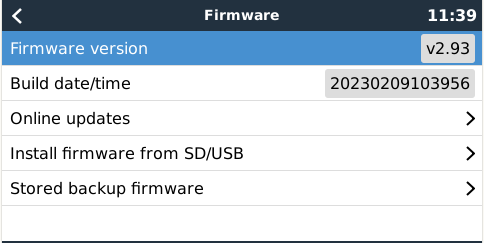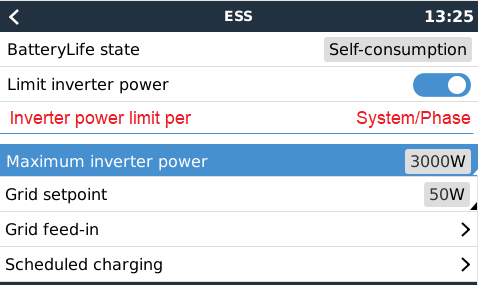Hi,
My new installed base is in a heat isolated shed with relatively constant temperature and good ventilation. Winter doesn’t seem to be an issue, the temperature has never dropped under 8°C in the last years3-phase 3x MultiPlus 2 48/3000/35-32

.
What I am concerned about is the summers with nowadays usual 35+ °C. Time to time my inverters might run at their max specification power which creates significant heat and heated up already the shed to ~25°C while the outside temperature was about 18°C. I am installing a ventilation system with temp sensor in order to tackle with the heat issue.
In addition, I played a bit with the ESS settings on the GX and my conclusions are as follows.
When there is no “Maximum inverter power” set in the GX, then the inverter will provide the power what is requested on the Critical load output and eventually, it limits itself to its maximum power (I hope) depending on the ambient temperature and the load and compensate from the grid the additionally required power.
However, I have seen the following situation in my 3-phase installed base. I ran 3300W on L3 for about 10min and the inverter didn’t throw any alarm/warning signal stating, that I am overloading the MP2 on that particular phase. In order to avoid any damage, I switched off the extra load.
Then I conducted the tests below playing with the “Limit inverter power” and “Maximum inverter power” in GX under ESS.
The conclusion is that the “Maximum inverter power” corresponds to the power of the combined power of the 3 inverters (MP2) in my 3-phase systems and not the individual inverters. This should be ok in case of parallel systems, but in 3-phase system the “Maximum inverter power” should correspond to the power of the individual phases, instead of the aggregate of them. Or at least it should have the option to select such operational mode.
This way one would be able to set a limit on the inverters serving a particular phase instead of the whole installation. The GX actually handles (to a certain degree) a 3-phase MP2 system as a single unit.
In my particular case, if I want to make sure during the hot summer days the inverters are not fried, then I switch on the “Limit inverter power” with a certain max inverter power.
Let’s say I take into consideration the Multi’s datasheet:
Continuous output power at 40°C (per Multi): 2200W
and set this value for the “Maximum inverter power”. This will serve me well in terms of not generating too much heat, but I am wasting lots of solar power -assuming the solar generates more than required- because the MP2s will limit the output power at 2200W aggregate power with a possible scenario of L1=L2=L3=733W from the inverter. (It will limit the power to the grid too because it is also inverter power)
Then I could set the max power to 3x 2200 = 6600W (concerning the 3-phases). If I do this, I could come to the scenario: L1=5000W load, L2=L3=1000W (7000W aggregate), which would result in the inverter on L1 will run at its max (whatever the factory set its limit to) power and overheating. The rest of the power on this particular phase is compensated from the grid of course. The other inverters are happily dealing with their own 1000W each.
However, if I was able to decide what the “Maximum inverter power” corresponds to, whether per system or per phase, then I could chose for example per phase and I would limit each of my inverter’s output power to 2200W in the hot summer days in order to avoid overheating, yet using the inverters more efficiently.
There should be a knob in GX to switch between these modes, something like this (see below).

I don’t think that his is too big of a challenge, so this should be put on the list of new features.
See my experiments below.
Test Case1:
Limit inverter power 1: YES
Maximum inverter power 1: 1000W
Battery is charged over “Active SOC limit”: YES
Active SOC limit: 55%
SOC: 89%
Fans stopped spinning -> MP2 passing through the Grid portion, it is not converted in any way, therefore, no loss occurs on the Grid portion.
1 : corresponds to full inverter power, in case of multi-phase systems the combined power of all phases
Critical loads:
Critical loads = Grid + Discharging -> 3200W = 2200W + 1000W
Battery:
Charging = PV Charger – Discharging – Charging & Calculation Losses
732W = 1818W – 1000W – 86W
Inverter (MultiPlus 2):
Discharging = Maximum inverter power
1000W = 1000W
Test Case2:
Limit inverter power 1: YES
Maximum inverter power 1: 2400W
Battery is charged over “Active SOC limit”: YES
Active SOC limit: 55%
SOC: 86%
Fans started spinning -> MP2 inverts all the required power, because it is below the maximum inverter power. There is no Grid portion, all power comes from the PV Charger and Battery combined
1 : corresponds to full inverter power, in case of multi-phase systems the combined power of all phases
Critical loads:
Critical loads = Grid + Discharging
3500W = 1100W + 2400W
Battery:
Charging = PV Charger – Discharging – Charging & Calculation Losses
-1360W = 1180W – 2400W – 140W
Inverter (MultiPlus 2):
Discharging = Maximum inverter power
2400W = 2400W
